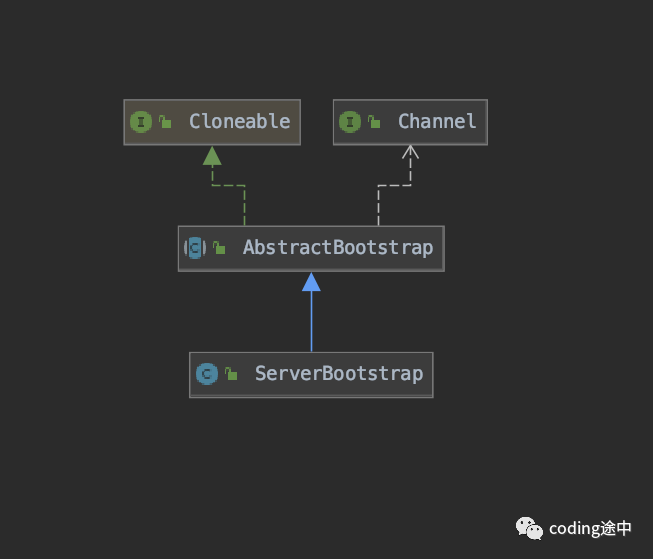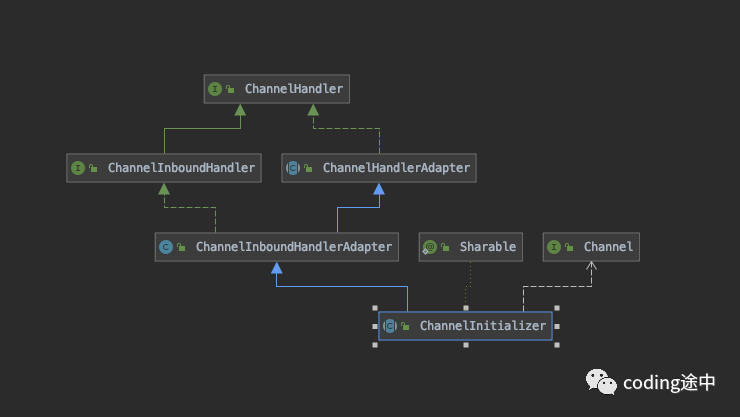这篇讲netty服务端ServerBootstrap如何启动
前言
BootStrap在netty的应用程序中负责引导服务器和客户端。netty包含了两种不同类型的引导:
使用服务器的ServerBootStrap,用于接受客户端的连接以及为已接受的连接创建子通道。 用于客户端的BootStrap,不接受新的连接,并且是在父通道内完成一些操作。
一般服务端的代码如下所示:
public final class SimpleServer {
public static void main(String[] args) throws Exception {
EventLoopGroup bossGroup = new NioEventLoopGroup(1);
EventLoopGroup workerGroup = new NioEventLoopGroup();
try {
ServerBootstrap b = new ServerBootstrap();
b.group(bossGroup, workerGroup)
.channel(NioServerSocketChannel.class)
.handler(new SimpleServerHandler())
.childHandler(new SimpleServerInitializer())
.option(ChannelOption.SO_BACKLOG, 128)
.childOption(ChannelOption.SO_KEEPALIVE, true);
ChannelFuture f = b.bind(8888).sync();
f.channel().closeFuture().sync();
} finally {
bossGroup.shutdownGracefully();
workerGroup.shutdownGracefully();
}
}
}
private static class SimpleServerHandler extends ChannelInboundHandlerAdapter {
@Override
public void channelActive(ChannelHandlerContext ctx) throws Exception {
System.out.println("channelActive");
}
@Override
public void channelRegistered(ChannelHandlerContext ctx) throws Exception {
System.out.println("channelRegistered");
}
@Override
public void handlerAdded(ChannelHandlerContext ctx) throws Exception {
System.out.println("handlerAdded");
}
}
public class SimpleServerInitializer extends ChannelInitializer<SocketChannel>{
@Override
protected void initChannel(SocketChannel ch) throws Exception {
ChannelPipeline pipeline = ch.pipeline();
pipeline.addLast("framer", new DelimiterBasedFrameDecoder(8192, Delimiters.lineDelimiter()));
pipeline.addLast("decoder", new StringDecoder());
pipeline.addLast("encoder", new StringEncoder());
pipeline.addLast("handler", new SimpleChatServerHandler());
System.out.println("SimpleChatClient:" + ch.remoteAddress()+"连接上");
}
}复制
在上篇博文(详细讲讲Netty的NioEventLoopGroup!)中 剖析了如下的两行代码内部的构造函数中干了些什么。
EventLoopGroup bossGroup = new NioEventLoopGroup(1);
EventLoopGroup workerGroup = new NioEventLoopGroup();复制
ServerBootstrap如何启动
本篇文章将分析如下几行代码里面做了些什么。
ServerBootstrap b = new ServerBootstrap();
b.group(bossGroup, workerGroup)
.channel(NioServerSocketChannel.class)
.handler(new SimpleServerHandler())
.childHandler(new SimpleServerInitializer())
.option(ChannelOption.SO_BACKLOG, 128)
.childOption(ChannelOption.SO_KEEPALIVE, true);复制

我们看下构造函数将workerGroup保存在 ServerBootstrap对象的childGroup属性上。bossGroup保存在ServerBootstrap对象的group属性上
public ServerBootstrap group(EventLoopGroup parentGroup, EventLoopGroup childGroup) {
super.group(parentGroup);
if (childGroup == null) {
throw new NullPointerException("childGroup");
}
if (this.childGroup != null) {
throw new IllegalStateException("childGroup set already");
}
this.childGroup = childGroup;
return this;
}复制
设置父类属性channelFactory 为:BootstrapChannelFactory类的对象。其中这里BootstrapChannelFactory对象中包括一个class属性为:NioServerSocketChannel.class,从如下该类的构造函数中可以明显的得到这一点。
public B channel(Class<? extends C> channelClass) {
if (channelClass == null) {
throw new NullPointerException("channelClass");
}
return channelFactory(new BootstrapChannelFactory<C>(channelClass));
}
public B channelFactory(ChannelFactory<? extends C> channelFactory) {
if (channelFactory == null) {
throw new NullPointerException("channelFactory");
}
if (this.channelFactory != null) {
throw new IllegalStateException("channelFactory set already");
}
this.channelFactory = channelFactory;
return (B) this;
}复制
并且BootstrapChannelFactory中提供 newChannel()方法,我们可以看到 clazz.newInstance(),主要是通过反射来实例化NioServerSocketChannel.class
rivate static final class BootstrapChannelFactory<T extends Channel> implements ChannelFactory<T> {
private final Class<? extends T> clazz;
BootstrapChannelFactory(Class<? extends T> clazz) {
this.clazz = clazz;
}
@Override
public T newChannel() {
try {
return clazz.newInstance();
} catch (Throwable t) {
throw new ChannelException("Unable to create Channel from class " + clazz, t);
}
}
@Override
public String toString() {
return StringUtil.simpleClassName(clazz) + ".class";
}
}复制
❝这里的handler函数的入参类是我们自己提供的。如下,后面的博文中将会分析这个handler将会在哪里以及何时被调用,这里只需要记住这一点即可
❞
public B handler(ChannelHandler handler) {
if (handler == null) {
throw new NullPointerException("handler");
}
this.handler = handler;
return (B) this;
}复制
由最后一句可知,其实就是讲传入的childHandler赋值给ServerBootstrap的childHandler属性。
该函数的主要作用是设置channelHandler来处理客户端的请求的channel的IO。这里我们一般都用ChannelInitializer这个类的实例或则继承自这个类的实例 这里我是通过新建类SimpleChatServerInitializer继承自ChannelInitializer。具体的代码如下
public ServerBootstrap childHandler(ChannelHandler childHandler) {
if (childHandler == null) {
throw new NullPointerException("childHandler");
}
this.childHandler = childHandler;
return this;
}复制
由最后一句可知,其实就是讲传入的childHandler赋值给ServerBootstrap的childHandler属性。
该函数的主要作用是设置channelHandler来处理客户端的请求的channel的IO。这里我们一般都用ChannelInitializer这个类的实例或则继承自这个类的实例 这里我是通过新建类SimpleChatServerInitializer继承自ChannelInitializer。具体的代码如下:
public class SimpleChatServerInitializer extends ChannelInitializer<SocketChannel>{
@Override
protected void initChannel(SocketChannel ch) throws Exception {
ChannelPipeline pipeline = ch.pipeline();
pipeline.addLast("framer", new DelimiterBasedFrameDecoder(8192, Delimiters.lineDelimiter()));
pipeline.addLast("decoder", new StringDecoder());
pipeline.addLast("encoder", new StringEncoder());
pipeline.addLast("handler", new SimpleChatServerHandler());
System.out.println("SimpleChatClient:" + ch.remoteAddress()+"连接上");
}
}复制
我们再看看ChannelInitializer这个类的继承图可知ChannelInitializer其实就是继承自ChannelHandler的

可知,这个类其实就是往pipeline中添加了很多的channelHandler。
ServerBootstrap的option
这里调用的是父类的AbstractBootstrap的option()方法,源码如下:
public <T> B option(ChannelOption<T> option, T value) {
if (option == null) {
throw new NullPointerException("option");
}
if (value == null) {
synchronized (options) {
options.remove(option);
}
} else {
synchronized (options) {
options.put(option, value);
}
}
return (B) this;
}复制
其中最重要的一行代码就是:options.put(option, value); 这里用到了options这个参数,在AbstractBootstrap的定义如下:private final Map<ChannelOption, Object> options = new LinkedHashMap<channeloption</channeloption
ServerBootstrap的childOption
这里调用的是父类的ServerBootstrap的childOption()方法,源码如下:
public <T> ServerBootstrap childOption(ChannelOption<T> childOption, T value) {
if (childOption == null) {
throw new NullPointerException("childOption");
}
if (value == null) {
synchronized (childOptions) {
childOptions.remove(childOption);
}
} else {
synchronized (childOptions) {
childOptions.put(childOption, value);
}
}
return this;
}复制
这个函数功能与option()函数几乎一样,唯一的区别是该属性设定只作用于被acceptor(也就是boss EventLoopGroup)接收之后的channel。到此为止netty的初始化设置完成,下篇文章我们讲一下启动过程。
结束
❝识别下方二维码!回复: 「
❞入群
」 ,扫码加入我们交流群!








